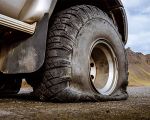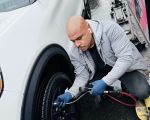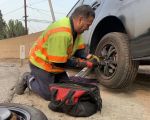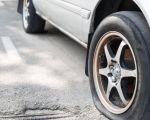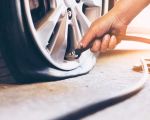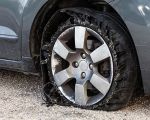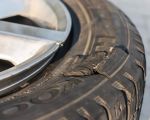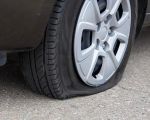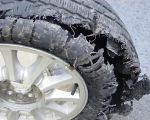How to Check Tire Health to Prevent Blowouts
As a driver, one of the most concerning situations I’ve encountered is the fear of a tire blowout, especially when I’m traveling on the highway at high speeds. If you've ever had a tire blow out unexpectedly, you know how unsettling and potentially dangerous it can be. Over the years, I’ve learned that regular tire checks and maintenance are essential for preventing blowouts and ensuring my safety on the road. In this article, I’m going to share with you the steps I’ve taken to check tire health, how to spot early warning signs of tire damage, and how simple tire care can help avoid major problems.
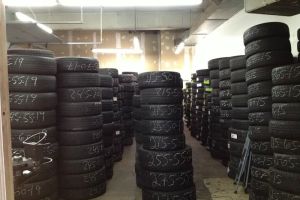
MR. TIRE INC.
2078 New York Ave, Huntington Station, NY 11746, USA
1. Understanding the Importance of Tire Health
Before diving into how to check your tires, it’s important to understand why maintaining tire health is crucial. Tires are the only part of your vehicle that come in direct contact with the road, and they bear the full weight of your car while also providing traction, stability, and control. Over time, tires can wear down, crack, or develop internal damage, which can lead to dangerous blowouts or flats. The more I learned about tire health, the more I realized how easy it is to prevent these issues with a little regular attention.
The first thing I did was start paying more attention to tire pressure, tread depth, and visible damage. These are the key factors that contribute to a tire’s health and performance. Regularly checking these aspects can save you from finding yourself stranded or, worse, in an accident caused by a blowout. Tire health isn’t just about safety; it’s also about maximizing the longevity of your tires and avoiding costly repairs or replacements. So, let’s break down the steps you can take to keep your tires in top condition.

MR. TIRE INC.
2078 New York Ave, Huntington Station, NY 11746, USA
2. How to Check Tire Pressure
When I first started focusing on tire health, the first thing I learned was how important tire pressure is. Both under-inflated and over-inflated tires can cause premature wear and increase the risk of a blowout. Tires that are too low in pressure are more likely to overheat, while those that are too high have less contact with the road, which can lead to uneven wear. That’s why checking your tire pressure regularly is essential.
The easiest way to check tire pressure is with a tire pressure gauge. Here’s how I do it:
- Purchase a tire pressure gauge: I keep a digital or manual tire pressure gauge in my car for quick checks. You can find these at most auto parts stores or online.
- Check the manufacturer’s recommended tire pressure: The correct tire pressure is usually listed in the vehicle’s owner’s manual or on a sticker inside the driver’s side doorframe. I always make sure to follow this recommended pressure, which is typically measured in PSI (pounds per square inch).
- Measure the pressure: Remove the valve stem cap from your tire and place the tire pressure gauge onto the valve stem. Press firmly to get a reading. Repeat for each tire.
- Adjust the pressure: If the tire pressure is too high, I release some air; if it's too low, I add air using a compressor. I do this to ensure all my tires are at the correct PSI.
Regular tire pressure checks should be part of your monthly routine, especially before long trips. I always check the pressure when the tires are cold, as this gives the most accurate reading.
3. Inspecting Tire Tread Depth
The next important factor I check is the tread depth. Tread helps my tires grip the road, especially when driving in wet or slippery conditions. Over time, the tread on your tires will wear down, and this can drastically affect the tire’s ability to handle the road, especially during rain. A tire with low tread is at a much higher risk of hydroplaning, and in severe cases, it can lead to a blowout.
To check the tread depth, I use a tread depth gauge or simply the penny test, which is what I’ve been doing for years:
- The Penny Test: Place a penny into the tire’s tread groove with Lincoln’s head facing down. If I can see the top of Lincoln’s head, it means the tread depth is too low, and it’s time to replace the tire.
- Using a Tread Depth Gauge: A more precise method is using a tread depth gauge, which can be purchased at any automotive store. It measures how deep the grooves are and provides an accurate reading to determine if the tread is still within a safe range.
Generally, if the tread depth is less than 2/32 of an inch, I know it’s time for new tires. This is because a shallow tread will not perform well, especially in rainy or snowy weather, and is more prone to a blowout.
4. Visual Inspections: Look for Tire Damage
Every time I do a quick walk-around of my car, I make it a habit to visually inspect my tires for any visible signs of damage. This is one of the simplest yet most effective ways to prevent a blowout. I look for:
- Cracks: If I notice any visible cracks or cuts in the sidewalls, I know the tire might be compromised. These can develop over time from heat and UV exposure.
- Bubbles: A bubble on the sidewall can indicate internal damage, which can lead to a blowout. I always get tires with bubbles replaced immediately.
- Bulges: Similar to bubbles, bulges in the tire can cause serious problems. If I find any, I make sure to replace the tire before it gets worse.
- Foreign Objects: Nails, screws, or other debris can get stuck in my tires, causing slow leaks. I make sure to remove any objects and get the tire patched or replaced if necessary.
Performing a visual inspection regularly helps me catch problems early, which reduces the chances of a blowout while driving. It’s especially important after hitting potholes or curbs, which can sometimes cause hidden damage to the tire that isn’t immediately visible.
5. Understanding Tire Age and When to Replace Tires
One of the most eye-opening things I learned about tire health was how age affects a tire’s performance. Even if my tires look fine, the rubber degrades over time due to exposure to heat, cold, and UV rays. This is why tire manufacturers recommend replacing tires every six years, and I make sure to check the manufacture date on the sidewall of my tires.
The DOT code on the tire’s sidewall provides the date of manufacture, showing the week and year the tire was made. Tires that are 10 years old or older should be replaced, even if they appear to have plenty of tread. The rubber can become brittle and unsafe, increasing the risk of a blowout.
6. Driving Habits That Impact Tire Health
Besides regular checks and inspections, I’ve found that my driving habits play a big role in tire longevity. Here are a few things I’ve learned over the years:
- Avoid Overloading: Carrying too much weight in my vehicle can stress the tires, causing them to wear unevenly or overheat. I make sure to follow the recommended weight limits for my vehicle.
- Avoid Abrupt Driving: I’ve noticed that harsh braking and fast accelerations increase the strain on my tires, leading to uneven wear. I always try to drive smoothly, especially on highways.
- Proper Tire Rotation: Rotating my tires regularly helps ensure even wear. I typically do this every 6,000 to 8,000 miles, or as recommended by my vehicle’s manual.
7. Conclusion: Keeping Tires Safe to Prevent Blowouts
By following these simple steps to check tire health, I’ve been able to significantly reduce the chances of experiencing a blowout. Regular maintenance, from checking tire pressure and tread depth to conducting visual inspections, can make a huge difference in the safety and longevity of my tires. If you’re not sure about your tire health, don’t hesitate to get a professional inspection. Your tires are a crucial part of your vehicle, and taking the time to care for them properly is an investment in your safety on the road.
SEO Title: How to Check Tire Health and Prevent Blowouts SEO Keywords: tire health, prevent tire blowouts, tire pressure, tire tread, check tire damage SEO Description: Learn how to check your tire health and prevent blowouts. Discover tips for maintaining your tires, checking tread depth, and ensuring safety on the road.












